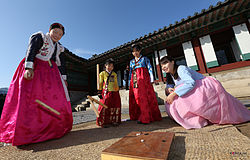Korean New Year
| Korean New Year | |
|---|---|
 | |
| Also called | Seollal |
| Observed by | Korean people around the world |
| Type | Cultural |
| Significance | First day of the Chinese lunisolar calendar |
| Date | Typically the second new moon after the winter solstice |
| Related to | Chinese New Year, Japanese New Year, Mongolian New Year, Tibetan New Year, Vietnamese New Year |
Korean New Year (Hangul: 설날; RR: Seollal; MR: Sŏllal) is the first day of the Chinese lunisolar calendar.It is one of the most important traditional Korean holidays which orginated from China.[1] The celebration usually lasts three days: the day before Korean New Year, Korean New Year itself, and the day after Korean New Year. During this time, many Koreans visit family, perform ancestral rites, wear hanbok(한복), eat traditional food, and play folk games. Additionally, children often receive money from their elders after performing a formal bow (originated from Chinese HongBao). Most celebrations can be dated back to ancient China because Korea was a dependent country of China. Therefore, a lot of celebrations were strongly correlated to the traditional Chinese culture.
Korean New Year generally occurs in January or February on the second new moon after the winter solstice, unless there is a intercalary eleventh or twelfth month in the lead-up to the New Year. In such a case, the New Year falls on the third new moon after the solstice.[2] Korean New Year typically falls on the same day as Chinese New Year.[3]
References[change | change source]
- ↑ Encyclopedia of Korean Seasonal Customs. The National Folk Museum of Korea (South Korea). 2014. pp. 30–46. ISBN 978-8992128926.
- ↑ Crump, William D. (2014). Encyclopedia of New Year's Holidays Worldwide. McFarland. pp. 134–135. ISBN 978-1476607481.
- ↑ Turner, Barry, ed. (2016). The Statesman's Yearbook 2015: The Politics, Cultures and Economies of the World. Springer. p. 756. ISBN 978-1349672783.
